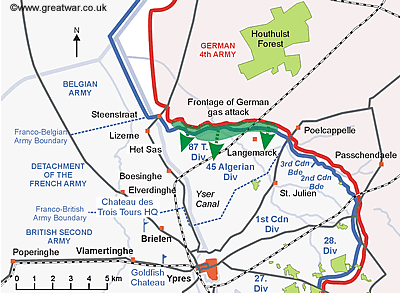 Canadians witness the green cloud
Canadians witness the green cloud
22 April 1915: 17.00
The left wing position of the British Second Army in the Ypres Salient was held by the 1st Canadian Division. On its left the French 45th Algerian Division was located the other side of the Franco-British Army Boundary. The 1st Canadian Division had three infantry brigades: namely 1st, 2nd and 3rd Infantry Brigades. Two of these, the 3rd and 2nd Canadian Infantry Brigades were located in the front line when the German attack was launched. (See below for a link to the British Order of Battle in the Prelude to the Battle.)

At 5pm men in 13th Canadian Battalion (Royal Highlanders of Canada), which was the left of the two front line battalions of the 3rd Canadian Brigade, heard the rattle of rifle fire from the direction of Langemarck and the French 75mm guns opening fire at a rapid rate. Word was passed along the Canadian line that the Germans were attacking the French.
The commander of No. 1 Company of 13th Battalion, Major D R McCuaig, went to investigate. He noticed that the sun had a peculiar greenish appearance.All Quiet on 3rd Brigade Front
At the time of the release of the gas cloud the 1st Canadian Division commander, Lieutenant-General E A H Alderson, CB, was inspecting the 3rd and 2nd Brigade sectors to the north-east of St. Julien. Accompanied only by his artillery commander, Brigadier-General Burstall, he was about 2 kilometres from the front line. Over the next hour General Alderson would have to make his way back on foot and on horseback as fast as he could to his headquarters at Chateau des Trois Tours. The headquarters was located in the chateau about 1 kilometre to the west of Brielen.
In the General's absence his headquarters had received the routine Situation Reports from both 2nd and 3rd Brigades at the front.
At 5.13pm the 3rd Canadian Brigade sent its Situation Report to the headquarters of 1st Canadian Division at the Chateau des Trois Tours reporting a green cloud of vapour (the message was received at divisional headquarters at 5.30pm):
“Situation quiet aaa Left Section reports observing at 5.00pm a cloud of green vaper [sic] several hundred yards in length between the French trenches to our left aaa Firing is very heavy at that place.” (1)
At 5.25pm the 2nd Canadian Brigade sent its Situation Report to 1st Division headquarters. It was received at 5.35pm:
“... aaa Section 1 situation normal aaa Section 2 fairly heavily shelled after 2.15pm some shells melinite aaa Heavy bombardment and rapid rifle fire heard on our left at 5pm aaa Shells bursting near report centre 5.15pm.” (2)
In response to these two messages the 1st Canadian Division sent a Situation Report to the British V. Corps headquarters in Poperinghe. It repeated the message to the British 28th Division and the French 45th Algerian Division. This Situation Report was sent at 5.50pm, 50 minutes after the release of the gas:
“No. 2 Brigade report trenches were shelled during day. No. 3 Brigade report all quiet on their immediate front.” (3)
First Message regarding the Ensuing Battle
It is believed that General Alderson must have arrived back at his headquarters from his visit to the front at this time, 5.50pm. Only five minutes after sending the above Situation Report saying that generally all was quiet on the Canadian front, the first of many messages and orders for the ensuing battle was sent. It was wired at 6pm from 1st Division headquarters to 3rd Brigade HQ and also to the 1st Canadian Divisional Artillery HQ requesting them give any help they could to the French who were being attacked on the Canadian left.(4)
The message to 3rd Brigade read:
“French 45th Division being heavily attacked aaa Order your Reserve Battalion [i.e. 14th Battalion in 3rd Brigade Reserve] to stand by aaa Render any help possible by rifle fire on your part aaa Our artillery has been directed to support the French.” (5)
The message to the Canadian Divisional Artillery read:
“French 45th Div. being attacked on their right and centre aaa Help by bringing arty. [artillery] fire to bear.” (6)
10th Canadian Battalion in Reserve in Ypres
The 10th Canadian Battalion was located in billets in Ypres in the 1st Canadian Divisional Reserve. At 4.45pm the Battalion War Diary states the following about the appearance of the cloud of gas:
“MAJ McLAREN [and] MAJ ORMOND and CAPT GLIDDEN (M.O.) [Medical Officer] riding between ELVERDINGHE and BRIELEN hear bombardment from NORTH EAST and see shells breaking also cloud of peculiar color (greyish, yellowish, greenish) darker near the ground and lighter in color [sic] near top.” (7)
With regard to the anticipation of the launch of an attack by the Germans the War Diary continues:
“5.15 p.m.: Meeting of officers with O.C. [Officer Commanding] at BN. H.Q. [Battalion Headquarters] when order of strange nature was noticed, a heavy shelling of YPRES was going on the heaviest of guns being used, the windows in the room in which we were gathered were smashed by concussion.” (8)
Next>> 3rd Canadian Brigade reserves “Stand to Arms”
Notes
British Order of Battle, 22 April 1915
Acknowledgements
(1) War Diary of 1st Canadian Division, April 1915 Appendices: National Archives ref. WO95/3717
(2) Official History of the Canadian Forces in The Great War 1914-1919, Appendices, no. 341, p. 239
(3) Official History of the Canadian Forces in The Great War 1914-1919, Appendices, no. 343, p. 239
(4) Gas! The Battle for Ypres, 1915, p. 63
(5) War Diary of 1st Canadian Division, April 1915 Appendices: National Archives ref. WO95/3717
(6) Official History of the Canadian Forces in The Great War 1914-1919, Appendices, no. 345, p. 239
(7) War Diary of 10th Canadian Battalion, April 1915: National Archives ref. WO 95/3770
(8) War Diary of 10th Canadian Battalion, April 1915: National Archives ref. WO 95/3770